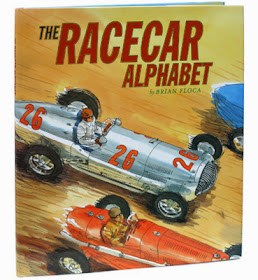Percy Jackson's Greek GodsRight from the introduction, it's clear that this is no ordinary retelling of the classic Greek myths. Percy is on top form, combining good natured humor and sarcastic wit:
by Rick Riordan
illustrated by John Rocco
Disney Hyperion, 2014
Google Books preview
Your local library
Amazon
ages 9 - 14
"I hope I'm getting extra credit for this," Percy Jackson starts. "A publisher in New York asked me to write down what I know about the Greek gods, and I was like, 'Can we do this anonymously? Because I don't need the Olympians mad at me again.'"While we haven't read the rest of the Percy Jackson novels together, my daughter knows plenty about them from her friends. She's curious about the Greek gods, but it's really Percy's voice that captured her attention.
Percy starts from the very beginning of time, with Chaos ("a gloomy, soupy mist with all the matter in the cosmos just drifting around"), Gaea the Earth Mother, and Ouranos the sky. Riordan packs a huge amount of detail into his tales, and we are finding it hard to keep track of all the names. So far, we've watched Kronos overthrow his father Ouranos, with the help of his four brothers Koios, Iapetus, Krios and Hyperion. And now Kronos is terrified that his father's curse will come true, and he will be destroyed by his own children. But the main characters are familiar to me, so I can help keep us on track.
 |
| "Without a word, (Ouranos) wrapped them in chains and tossed them into Tartarus like bags of recycling." |
Want to have a taste of Percy's irreverent tone? Just read this chapter that begins the section on the Olympians and you'll see why this book has my 10 year old giggling each night:
"Why is Zeus always first?I just love the way Riordan infuses his retellings with plenty of modern attitudes. "Maybe you'll feel better about your own relatives, knowing that the first family in creation was also the first dysfunctional family." But he also doesn't skimp on the details, foreign names and intricate family trees. That's why this is working so terrifically as a read-aloud.
Seriously, every book about the Greek gods has to start with this guy. Are we doing reverse alphabetical order? I know he's the king of Olympus and all--but trust me, this dude's ego does not need to get any bigger.
You know what? Forget him.
We're going to talk about the gods in the order they were born, women first. Take a backseat Zeus. We're starting with Hestia."
John Rocco's illustrations are magnificent. As Kirkus Reviews states, they "smoke and writhe on the page as if hit by lightning." Head over to John's blog to read more about his artwork and see sketches of some of the interior art as he is developing it.
An index, list of illustrations and suggestions for further reading are included in the back matter. My one complaint at this point is I wish there was a family tree and/or list of all the characters with a pronunciation guide. In the meantime, I think I will print out either this basic family tree from Encyclopedia Mythica.
The review copy was kindly sent by the publisher, Disney Hyperion Books. If you make a purchase using the Amazon links on this site, a small portion goes to Great Kid Books. Thank you for your support.
©2014 Mary Ann Scheuer, Great Kid Books























